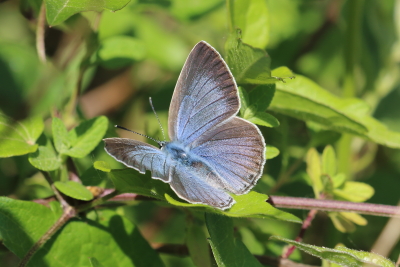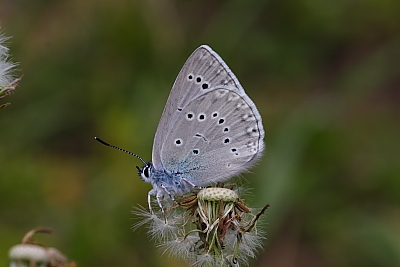








Iolas Blue (Iolana iolas)
2022 photographs highlighted in blue. Click on any photograph to go to an enlarged picture, or simply scroll down the page.
|
Iolas is an exceptionally large blue, the largest in Europe, being rather larger than the Phengaris (previously Maculinea) species. It is also exceptionally scarce and probably in decline. It occurs in two or three known locations in Var (maybe more sites are yet to be discovered) although more widespread in the Alpes-de-Haute-Provence, and is very much tied to the larval hostplant Bladder Senna (Colutea arborescens). The male upperside is a clear bright blue and the female blue with wide dark borders. |
The flight period is said to be mid-May (there is a suggestion of a possible second brood), although the first male I saw in 2011 was looking rather worn on 20 May. It occurs in very low densities, usually only ones and twos, but it has a very powerful soaring flight and is apparently capable of wandering long distances from the Colutea. A superb video of the life-cycle of iolas has been produced by Filming VarWild and can be viewed on YouTube here: www.youtube.com/watch?v=62mGXCiQNfM |
|
ref |
sex |
observations |
alt. m |
|
29333 |
M |
a male, showing the clear blue colour. |
480 |
| 32443 | F | a female upperside, showing the thick black borders that differentiate it from the male. | 370 |
| 40610 | F | a female, resting in between bouts of egg-laying. | 370 |
|
29120 |
M |
a male, showing quite well-developed marginal markings. |
480 |
|
29340 |
M |
a male, nectaring on the Colutea - note the proboscis enters at the base of the flower. |
370 |
| 32344 | F | a female underside, soon after emergence. It is not the same individual as in 32397. | 370 |
| 37055 | F | a female, rather bluish in ground colour than other females I have seen. | 370 |
| 32397 | PAIR | a mating pair, the female on the right, virtually pristine as it is soon after emergence. | 370 |
|
29152 |
Colutea arborescens, the larval hostplant. |
370 |
29152_larval hostplant_Var_7May12